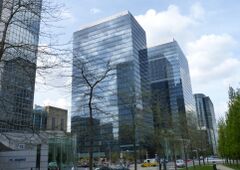Grand Avenue
 A nineteenth-century painting of Grand Avenue (erroneously, it depicts a bend) | |
| Length | 4.9 km (3.0 mi) |
|---|---|
| Northwest end | C1 Motorway |
| Major junctions | Bishop's Street Operetta Lane Razeth Street |
| Southeast end | Government Chambers and Emerald Quay |
| Construction | |
| Construction start | 1642 |
| Other | |
| Designer | Oskar ti'Tartharim |
Grand Avenue (Khadenz: Asatxi Sereg) is the main road in the city of Cadenza, running the length of the city's Great Central Ward for a distance of about 4.9 kilometres (3.0 mi). Mostly built after the Burning of Cadenza in 1641, it is a long, broad boulevard with a tree-lined median. The avenue runs parallel to the later Duke of Lindros Avenue, both running northwest-southeast. At its southeast end is Government Chambers, surrounded by other government and administrative buildings such as the Judicial Palace, after which the roadway turns southward and continues as Emerald Quay following the south bank of the Temloth. Along the north side of the avenue, at its northwest end, are the modern office blocks and skyscrapers that make up part of the Astyrian Financial Centre, beyond which is Junction 11 (southbound only) of the C1 motorway with Grand Avenue.
History
In the first half of the seventeenth century, inner Cadenza was a densely-packed labyrinth of streets and lanes radiating from the riverside quays. This network had grown up organically over the previous four hundred years, since the 1274 Great Fire, the last major medieval fire to sweep the city. During the Burning of Cadenza, in 1641, fire spread rapidly among the wooden upper storeys of the closely-built buildings, and much of the city's core was destroyed, particularly on the south bank. Most bridges over the Temloth were also lost, as were the lavish Ducal Palace and the Conciliar Theatre, where the organs of government were based.

In the aftermath of the disaster, the Joint Councils resolved to rebuild the city in a way that "should rebuff any claim that the Fire has put Cadenza down" while preventing another disaster from crippling the city's trade and the national government. Calls to remove the government out of the city, for example to Ro'ekha in the north, were rejected. The Duke, earl Pahrek of Cadenza, was particularly insistent that the national government should remain in his capital. The Canvian architect Oskar ti'Tartharim was commissioned to design a new urban layout. The city's main street, marked Grand Avenue (asatxi sereg) on his drawings, was to run in a straight line roughly parallel to the river and beginning from the site of the old Conciliar Theatre. ti'Tartharim envisioned broad avenues intersecting only at right angles, with the city's centrepiece a magnificent circular plaza at the avenue's midpoint. In this plaza was to be erected a fountain commemorating the War of the Magpie and the Dragon, a bold statement of Cadenza's military achievements against much larger foes. ti'Tartharim's plan was lavish and expensive, and had it been followed fully would have required the demolition of numerous buildings that had survived the fire. In 1643, however, as work was progressing at the southeast end of the avenue, he was murdered over his considerable debts to the city's moneylenders, and the contract for overseeing the works was then awarded to a rival, Kosatis Linna of Vedkathna.

Under pressure from landowners who feared to lose their property along the road, Linna deviated from the plan and allowed a number of side streets to remain at imperfect angles; Operetta Lane is one notable example. The central plaza was also dropped from the plans in favour of a covered market, the Sugartraders' Gallery, at the intersection of Grand Avenue and Bishop's Street. This market burned down in a fire in 1897 and was replaced in the 1910s by the Temloth Arcades. A commemoration of the War of the Magpie and the Dragon was not erected until 1914, outside Government Chambers.
As the fire had forced many residents to abandon the city centre, and the new buildings were taller than the old, a proposed boulevard parallel to Grand Avenue was not built until the 1680s, and the area behind the buildings in Grand Avenue's southern side was left as a long meadow for several decades. First known as Park Avenue, that later boulevard was later renamed Duke of Lindros Avenue, following the martial achievements and philanthropy of the Trellinese Modriq, Duke of Lindros in the War of the Velaran Succession. Development northwestward along the road was gradual over the following century and showed a visible decrease in quality, particularly beyond its Razeth Street junction. Much of this was subsequently redeveloped, such that towards its northwest end the avenue is characterised by tall towers of glass and steel rather than ornamental marble and limestone.
Description
Grand Avenue carries two-directional traffic along its entire 4.9-kilometre (3.0 mi) length, with two lanes in each direction. Towards its southeast end, one lane in each direction is replaced with segregated cycle lanes and a widened footpath.
Junctions
Shops, businesses and landmarks
- Adeodachus
- Bank of Yohannes
- Cadenza Financial
- Government Chambers
- Ilius Financial
- Judicial Palace
- Les Cristaux Bank
- Príomhbanc Maltróipea
